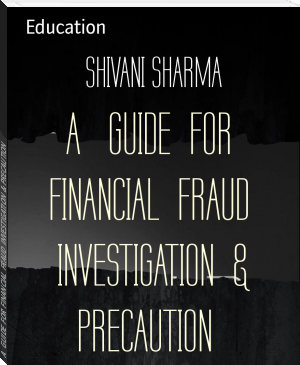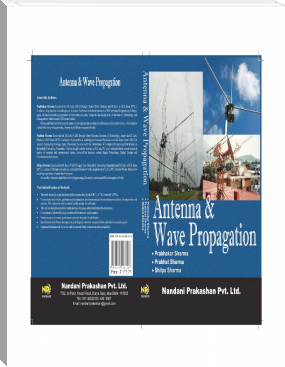A GUIDE FOR FINANCIAL FRAUD INVESTIGATION & PRECAUTION, SHIVANI SHARMA [read my book txt] 📗

- Author: SHIVANI SHARMA
Book online «A GUIDE FOR FINANCIAL FRAUD INVESTIGATION & PRECAUTION, SHIVANI SHARMA [read my book txt] 📗». Author SHIVANI SHARMA
5. In exceptional cases, the complainant can directly report his/her complaint to the Chairperson of the respective Audit Committee. Details of the Chairperson is available on the Company website.
Procedure for handling a complaint is as given below:
1. A whistle blower identifies non-adherence of Group Values or Aditya Birla Group’s Code of Conduct by any employee or a segment of the organization, will compile information that supports the case.
2. The whistle blower sends the complaint to the respective Value Standards Committee or ethics hotline, depending on: The level at which the violation is perceived to be happening, or The seniority of the individual/s involved. If the breach or misdemeanor is at: The Unit Head level (Strategic Business Unit Head, Regional Head, Circle Head, Unit Head etc) and above, the employee will write to the Group level Value Standards Committee (GVSC) Unit Function Head level, the same will be reported to the respective Business level Value Standards Committee (BVSC)
5
Any other level, the same will be reported to the respective Unit level Value Standards Committee (UVSC)
3. Upon receipt of information, the secretary of the relevant Values Standard Committee will first do a preliminary investigation to check whether the complaint seems to be genuine and falls under the purview of whistle blower policy. If complaint is sent with malicious intent, then the committee will take appropriate disciplinary action against the whistle blower.
4. If complaint does not fall under purview of whistle blower policy, then same would be redirected to the right forum. For eg – If complaint is related to sexual harassment, same will be forwarded to the Complaints Committee and would be dealt as defined under circular no. 728. – Policy to Prevent Sexual Harassment at the Workplace If complaint is related to a personal grievance, e.g. appraisal rating, promotion etc, it will be forwarded to the relevant Chief People Officer.
5. Once established that the case needs investigation, the secretary of the Value Standards Committee after discussion with the committee shall appoint a team to investigate the case, with utmost confidentiality. The investigative team can be a pool of internal people specially trained to investigate or can be an external agency specialized to investigate such cases.
6. Under no circumstances, the secretary, investigation team and the committee would reveal / disclose the identity of the “accused‟ to anyone else (including the immediate manager) – other than all those who are required to know about the case.
7. The investigation team should work towards ensuring that the investigation is completed by following the laws of the land and principles of natural justice within 3 weeks of the complaint being reported. If the investigation cannot be completed within 3 weeks, then the committee needs to have very valid and strong reasons for the same.
8. Once the investigation is completed, the secretary will submit the report of investigation to the committee and the committee will then decide on the quantum of punishment to be given. While deciding on this, the committee will consider the following:
Severity of the misconduct Impact on the Organization (Reputation, Financial / Non – Financial) Past record of the employee Past precedence of treating similar violations (a summary of the same will be kept with Organization Effectiveness portfolio at Group Human Resources)
9. The punishment shall constitute a minimum of written warning and may lead to withdrawal of last increment/ demotion, withholding promotion, dismissal from service and/ or even prosecution in a court of law.
10. Once the report is received, the committee will put its recommendation and forward it to the respective Management team. The team will consider the recommendation and decide on appropriate action within 15 days of receiving the recommendation.
11. While implementing the recommendation, the management will ensure that the name of the whistle blower and the person accused is kept confidential at all times.
6
12. In case the whistle blower or the person accused is not satisfied with the decision of the relevant Value Standard Committee, he/she has the option to appeal within 7 days of the order, to the next higher-level committee.
13. Based on the appeal, the next higher-level committee will decide whether to re- investigate / relook at the quantum of punishment. The next higher-level committee will close the case within 21 days of receiving the appeal.
14. If the charges framed on the accused is found to be false after investigation, it is very essential to demonstrate that the employee’s dignity is respected. Hence, the Business Head / Unit Head should thank the employee personally for having cooperated in the process. A formal closure letter has to be sent informing that the charges has not been proved during the investigation process and hence he / she is fully exonerated of all the charges.
Reporting process An Annual and Quarterly report will be prepared by the Business Value Standards Committee of which copies will be placed before the Audit Committee of the relevant Group Company and Organization Effectiveness portfolio at Group Human Resources.
Guidelines for communication and implementation of this policy An ethics hotline is made available. This toll free number will be available for reporting of any violation or misconduct. A communication mechanism should be put in place to create awareness about this policy with the existing employees and for new joinees in all Group Companies operating in India.
It is the responsibility of the Chief People Officer of relevant Group Company to ensure that the updated names and email id of the various Business and Unit level Value Standards Committee is made available to all employees through the local intranet and/or any other communication mechanism they may adopt. A copy of this policy shall also be placed on the corporate website of the relevant Group Company.
A separate, detailed Operationalizing Guideline is available for each Values Standard Committee to ensure that this policy is implemented in letter and spirit. The details of the Values Standard Committee is available on Values Microsite on Poornata.
Important Templates Annexure 1 – Template for reporting violations Annexure 2 – Sample workflow /procedure for reporting, resolving and closing a case
7
Annexure 1 - Template for Reporting Violation
To: Value Standards Committee <at Group/ Business or Unit level>: ____________________
Please select the applicable incident type(s) from the list below that best describes the issue(s) you are reporting. Please note that multiple issues can be selected 1. Misappropriation of company assets or resources 2. Conflict of interest 3. Inappropriate sharing of confidential information 4. Financial fraud of any nature 5. Violation of gifts and entertainment policy 6. Non-adherence to safety guidelines 7. Inaccurate financial reporting 8. Bribery & Corruption 9. Insider trading 10. Other forms of Harassment – Victimization, Bullying, Discrimination etc. 11. Social Media Usage 12. Misuse of authority 13. Environment, health and safety 14. Concurrent employment 15. Others ___________________________________________________
Please provide name, designation and department of the person(s) involved?
Name Department Designation
Individual 1
Individual 2
Individual 3
Individual 4
When did the incident occur? (Please provide tentative date if you do not know the exact date)
________________________________________________
Please confirm the location of the incident
________________________________________________
How did you find out about this incident?
_________________________________________________________________________________
_________________________________________________________________________________
_________________________________________________________________________________
How long has this been occurring for?
8
Less than a month 1-6 months 6-12 months Greater than 12 months
Please provide a detailed description of the incident. To enable your company to act on your
complaint, you are requested to provide specific information where possible including names,
location, date, time etc. Please note that this field is limited to 5,000 characters.
_________________________________________________________________________________
_________________________________________________________________________________
_________________________________________________________________________________
Do you have any evidence in support of your allegations? Yes No
Is anyone else aware of this incident? Yes No
Is there any additional information that would facilitate the investigation of this matter? Yes No
Have you reported this incident to anyone in the company? Yes No
Date: __________________________
Location: ___________________________
Name of the Person reporting (optional): ___________________________
Contact Information (incl email optional): ___________________________
The complaint should be either reported on Values Microsite on Poornata to the relevant Values Standard Committee at Unit, Business or Group level or can be shared to ethics hotline at either verbally over a phone or through email. The details of the Values Standard Committee is available on Values microsite on Poornata and Onstream.
9
Annexure 2 - Sample workflow for reporting, resolving and closing a case 20 WAYS TO DETECT FRAUD
These are the following 20 ways to detect fraud.
unusual behaviour Complaints3.Stale Items in Reconciliations
4.Excessive voids
5.Missing doccuments
6.EXcess credit memose
7.Common name and addresses for refund
8.Increase in reconciling item
9.General leger out of balance
10.Adjustment in receviable or payebale
11.Exessive purchase
12.Duplicate payment
13.Ghost employees
14.Inventory shortage
15.Employee expense account
16.Incrased scrap
17.Large payments to individual
18.Employee overtime
19.Write-off of account receiveble
20.Post office address as shipping address
1. Unusual Behavior:-The perpetrator will often display unusual behavior, that when taken as a whole is a strong indicator of fraud. The fraudster may not ever take a vacation or call in sick in fear of being caught. He or she may not assign out work even when overloaded. Other symptoms may be changes in behavior such as increased drinking, smoking, defensiveness, and unusual irritability and suspiciousness.
2. Complaints:-Frequently tips or complaints will be received which indicate that a fraudulent action is going on. Complaints have been known to be some of the best sources of fraud and should be taken seriously. Although all too often, the motives of the complainant may be suspect, the allegations usually have merit that warrant further investigation.
3. Stale Items in ReconciliationsFrequently tips or complaints will be received which indicate that a fraudulent action is going on. Complaints have been known to be some of the best sources of fraud and should be taken seriously. Although all too often, the motives of the complainant may be suspect, the allegations usually have merit that warrant further investigation.In bank reconciliations, deposits or checks not included in the reconciliation could be indicative of theft. Missing deposits could mean the perpetrator absconded with the funds; missing checks could indicate one made out to a bogus payee.
4. Excessive Voids:-Voided sales slips could mean that the sale was rung up, the payment diverted to the use of the perpetrator, and the sales slip subsequently voided to cover the theft.
5. Missing Documents:-Documents which are unable to be located can be a red flag for fraud. Although it is expected that some documents will be misplaced, the auditor should look for explanations as to why the documents are missing, and what steps were taken to locate the requested items. All too often, the auditors will select an alternate item or allow the auditee to select an alternate without determining whether or not a problem exists.
6. Excessive Credit Memos:-Similar to excessive voids, this technique can be used to cover the theft of cash. A credit memo to a phony customer is written out, and the cash is taken to make total cash





Comments (0)